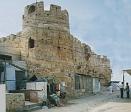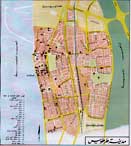 |
| in Syria |
|
Español | عربي |
Introduction Tartus or Tartous with over 160 000 inhabitants is second most important Syrian's coast after Latakia. It situated on the Mediterranean coast opposite Arwad Island and It is about 90 km from Homs, 251 km from Damascus, 105 km from Hama, and 90 km from Latakia. Tartus has developed rapidly over the recent years, and has nearly lost its charm as a small fishing town. History Tartus was founded in antiquity as Antaradus (Anti-Aradus - the town facing Arwad), a Phoenician colony of Aradus (now Arwad Island). It was rebuilt in AD 346 by Emperor Constantine I who renamed it Constantia and flourished during Roman and Byzantine times. It became a major Christian stronghold and during the fourth century a chapel was built here which is claimed to be the first dedicated to the Virgin Mary. An Earthquake in 487 AD largely destroyed the chapel but a miracle left its alter miraculously unscathed. Crusaders occupied Tartus, then known as Tortosa, in the European Middle Ages, converting it into a fortress-town and successfully defending it against devastating attacks in the 12th century. Crusaders built upon this miracle the church 'Our Lady of Tortosa' in 1123.This miracle was further enhanced by an icon of the Virgin believed to be painted by St. Luke resembling the one in Seidnaya. It now houses this altar and has received many pilgrims. Nur Al Din occupied Tartus for a brief time and then it was recaptured by the Crusaders. Tartus was placed under the control of the Templars who rebuilt and redeveloped its defenses. It was then recaptured by Saladin in 1188, whence the Templars locked themselves into the keep. However it was rebuilt and remained under Templar control until 1291. Tartous was the last stand the Templars had on the mainland of Syria departing to Arwad, which they kept for another decade. From the beginning of the Ottoman conquest, the town declined in importance until its port was rejuvenated in the 20th century. Attractions and historical building - The Cathedral of Our Lady of Tortosa, now the town's museum, is a perfect example of 13th-century crusader architecture. - The Castle of the Templars (late 12th to early 13th century), now mostly in ruins, can be seen in the older part of Tartus. - Other attractions include the old city and a city wall that preserves the beauty of the old city. The beaches and water are clean, and the accommodations are excellent. There are many hotels and restaurants in the area. - Just 3 km off the coast of Tartus is Syria's only island Arwad. it can be visited by a regular boat-ride service. Only 3 Km away, it only takes 20 minutes to get there. Arwad, or Arvad to the Phoenicians and Aradus to the Greeks and Romans, was first used for urban settlement by the Canaanites. It was often mentioned in inscriptions because of its importance in commerce and seafaring. Arwad provided shelter for those escaping from foreign invasions in ancient times, especially for the people of Amrit in the south of Tartus. Amrit still retains its name since the 5th century BC. It has a temple surrounded by water. Arwad is a beautiful, small island, with a mass of houses and fortresses and narrow lanes. It has many cafes and restaurants overlooking Tartus and the sea. Its ancient citadel was used as a prison for the nationalists during the resistance against the French. The walls of some cells in this citadel are still covered with the writings of the nationalists. - Other nearby attractions include Baniyas, Qalaat Yahmur, Qalaat Areimeh, Draykish, Qalaat Kadmous, Amrit, Safita. |
|||||||||||||||||||||||||||||||||||||||||||||||||||||
|
|
||||||||||||||||||||||||||||||||||||||||||||||||||||
|
|
|
|

Custom Search
|
| © Copyright Homsonline.com |
| |
||
| |
|
|



